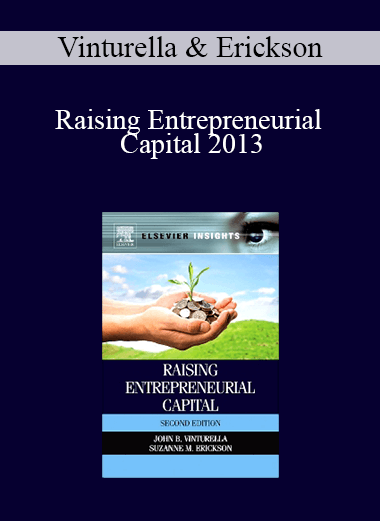Raising Entrepreneurial Capital
Raising Entrepreneurial Capital guides the reader through the stages of successfully financing a business. The book proceeds from a basic level of business knowledge, assuming that the reader understands simple financial statements, has selected a specific business, and knows how to write a business plan. It provides a broad summary of the subjects that people typically research, such as “How should your company position itself to attract private equity investment?” and “What steps can you take to improve your company’s marketability?”
Much has changed since the book was first published, and this second edition places effects of the global recession in the context of entrepreneurship, including the debt vs. equity decision, the options available to smaller businesses, and the considerations that lead to rapid growth, including venture capital, IPOs, angels, and incubators. Unlike other books of the genre, Raising Entrepreneurial Capital includes several chapters on worldwide variations in forms and availability of pre-seed capital, incubators, and the business plans they create, with case studies from Europe, Latin America, and the Pacific Rim.
Key Features
- Combines solid theory with a practitioner’s experience and insights
- Case studies illustrate theory throughout the book
- Updated to reflect the realities of the global economic recession
Readership
Students in entrepreneurship programs, particularly entrepreneurial finance courses, entrepreneur firms, and independent entrepreneurs
Table of Contents
- Dedication
- Preface
- Acknowledgments
- 1. Introduction
- Getting Started
- The Typical American Business
- Requirements for Being Considered a Small Business
- Small Businesses’ Role in the U.S. Economy
- Understanding the Characteristics of Small Businesses
- Examples of Opportunities for Self-Employed Entrepreneurs
- The Home-Based Alternative
- Is Fractional Entrepreneurship the Way to Start?
- Characteristics of Business Owners
- Global Entrepreneurship
- Creative Sources of Capital: Bootstrapping
- Initial Sources of Capital
- Small Firms’ Typical Use of Financial Services
- Bootstrap Strategies
- Growing the Business
- Raising Funds Using Social Networking
- Perspectives on Small Business Failure
- Organizational Form
- Ownership Structure and Capitalization
- Organization of the Book
- Summary
- Discussion Questions
- Case 1.1 New Tech (A): Overview
- Bibliography
- 2. Alternatives in Venture Financing: Debt Capital
- Introduction
- Case 2.1 SPS: Financing Strategy
- Case 2.2 MDO Products, Inc.: Start-Up Financing
- Case 2.3 Cajun Yachts, Inc.: Start-Up Financing
- Summary
- Discussion Questions
- Case 2.4 New Tech (B): How Much Do They Need?
- Appendix 2.1 New Tech (C): Financial Statements
- Appendix 2.2 New Tech (D): Financial Ratios
- Appendix 2.3 New Tech (E): Key Assumptions
- Bibliography
- 3. Alternatives in Venture Financing: Early-Stage Equity Capital
- Introduction
- Case 3.1 New Tech (F): Where Will the Money Come from?
- Summary
- Discussion Questions
- Case 3.2 New Tech (G): Are They Worth an Investor’s Time?
- Case 3.3 Ecoturista
- Bibliography
- 4. Determining the Amount Needed: The Business Plan
- Introduction
- Case Study Groupon.com Financial Statements
- Summary
- Discussion Questions
- Case 4.1 New Tech (H)
- Case 4.2 Web Wired
- Appendix 4.1 Sample Business Plan Template
- Bibliography
- Resources
- 5. Valuation: Survey of Methods
- Introduction: Valuation Methodologies
- Asset-Based Valuation
- Market Multiples
- Case 5.1 (A) Woodridge Corporation
- Case 5.2 (B) Superior Plumbing Supply
- Capitalization Rates
- Excess Earnings Approach
- Case 5.3 The Fairweather Company
- Free Cash Flow Valuation
- Case 5.4 (B) Woodridge Corporation: Illustrating the Free Cash Flow Model
- Summary
- Discussion Questions
- Case 5.5 New Tech (I): What Is the Company Worth?
- Appendix 5.1 Review of Ratio Analysis
- Summary
- Bibliography
- 6. Venture Capital
- Introduction
- The Venture Capital Process
- The Term Sheet
- Summary
- Discussion Questions
- Case 6.1 New Tech (J): Getting Investors’ Attention
- Key Tasks
- To Do
- Appendix 6.1 Sample Term Sheet
- Capitalization of the Company
- Bibliography
- 7. Exit Strategies
- Importance of the Exit Strategy
- Valuation by Revenue Multiples
- Returns at Exit
- Likeliest Options for Exit
- Management Buyout
- Individual Buyers
- Going Public
- Initial Public Offering
- Alternative Methods of Going Public
- Summary
- Discussion Questions
- Bibliography
- 8. Anatomy of a Venture Funding
- Case 8.1 New Tech (K): Finding Compatible Investors
- Case 8.2 New Tech (L): Getting Ready
- Case 8.3 New Tech (M): Choosing an Offer
- Case 8.4 New Tech (N): Closing the Deal
- 9. Franchising
- Chapter Goals
- Case Study 9.1 Franchising the Neighborhood Restaurant
- Summary
- Discussion Questions
- Bibliography
- Additional Resources
- 10. Internal Financial Management
- Introduction
- Summary
- Discussion Questions
- Case 10.1 New Tech (O): Monthly Cash Budget
- Bibliography
- 11. Essentials of Risk Management
- Introduction
- Summary
- Discussion Questions
- Bibliography
- Additional Resources
- 12. Opportunities to Do Business and Raise Capital Globally
- The Global Mind-Set
- Basic Considerations
- A Few Words About Communications
- Finding and Working with International Partners
- Sources of Information and Assistance
- Testing the Market
- Raising Equity Capital from International Sources
- Valuation and Monitoring
- Exit Strategies
- Regional Considerations
- Summary
- Discussion Questions
- Bibliography
About the Authors
John Vinturella
Dr. Vinturella was founder and 20-year President of a building supplies wholesaler, sold to a regional chain in 1998; Tammany Supply, Inc. was named a Blue-Chip Enterprise by the U.S. Chamber of Commerce in 1994 and was featured (“The Wizardry of Tammany Supply”) in the trade journal, Supply House Times. He also participated in the startup of several small businesses as officer/owner, including a microbrewery, software developer, “cajun” food manufacturer, and quick oil change franchise.He taught at Dillard University, New Orleans, LA, USA and is currently a Business Consultant in Cincinnati, Ohio, USA.
Affiliations and Expertise
Business Consultant, Cincinnati, OH, USA

Suzanne Erickson
Dr. Suzanne Erickson received her PhD in Finance from the University of Washington. She taught at Seattle University for several years where she was instrumental in starting the Entrepreneurship Center. Currently she is the Associate Dean in the College of Business and Mass Communication at Brenau University in Gainesville GA. Her areas of expertise are Corporate Finance, Valuation and Entrepreneurial Finance. In addition to publishing several articles in the areas of corporate finance and Raising Entrepreneurial Capital, a text coauthored with John Vinturella, she has consulted with several start-ups, Fortune 500 companies and non-profits.
Get download Vinturella & Erickson – Raising Entrepreneurial Capital 2013 at coursesblock.com right now!
Delivery Method
– After your purchase, you’ll see a View your orders link which goes to the Downloads page. Here, you can download all the files associated with your order.
– Downloads are available once your payment is confirmed, we’ll also send you a download notification email separate from any transaction notification emails you receive from coursesblock.com.
– Since it is a digital copy, our suggestion is to download and save it to your hard drive. In case the link is broken for any reason, please contact us and we will resend the new download link.
– If you cannot find the download link, please don’t worry about that. We will update and notify you as soon as possible at 8:00 AM – 8:00 PM (UTC 8).
Thank You For Shopping With Us!







